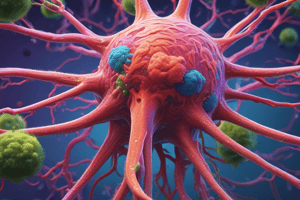Podcast
Questions and Answers
Which of the following scenarios best illustrates the immune system's response to a bacterial infection?
Which of the following scenarios best illustrates the immune system's response to a bacterial infection?
- An individual's body produces toxins to directly neutralize the bacteria.
- An individual's white blood cell count increases to combat the infection. (correct)
- An individual experiences a decrease in body temperature, inhibiting bacterial growth.
- An individual contracts a cold. This prevents the bacterial infection from affecting the lungs.
Why do adults tend to catch fewer colds as they age, in comparison to young children?
Why do adults tend to catch fewer colds as they age, in comparison to young children?
- Adults receive regular vaccinations that prevent all types of cold viruses.
- Adults' bodies are more efficient at producing specific antibodies due to prior exposures. (correct)
- Adults generally have weaker immune systems, resulting in less noticeable symptoms.
- Adults maintain better hygiene practices, completely avoiding exposure to viruses.
If a person lacked a functional immune system, what would be the most likely consequence of contracting a common cold virus?
If a person lacked a functional immune system, what would be the most likely consequence of contracting a common cold virus?
- The infection would spread to the lungs and cause additional complications. (correct)
- The cold would remain localized in the throat, causing only mild discomfort.
- The cold would be eliminated faster than normal due to lack of inflammation.
- The virus would be neutralized by the body's natural toxins.
How does the immune system's response to a mosquito bite demonstrate its function?
How does the immune system's response to a mosquito bite demonstrate its function?
What is the direct role of white blood cells in defending the body against viruses?
What is the direct role of white blood cells in defending the body against viruses?
Flashcards
Immune System
Immune System
Defends the body against infections by attacking germs like bacteria, viruses, fungi, and toxins.
Fever
Fever
A sign that your immune system is actively fighting off an infection or responding to a foreign substance.
White Blood Cells
White Blood Cells
Key cells of the immune system that attack and kill viruses.
Vaccine's Role
Vaccine's Role
Signup and view all the flashcards
Immune System's Purpose
Immune System's Purpose
Signup and view all the flashcards
Study Notes
- Immune (Lymphatic) System
Structures and Functions of the Immune System
- The immune or lymphatic system defends the body against infections.
- It attacks germs such as bacteria, viruses, fungi, and toxins.
- A fever indicates your immune system is active.
- A mosquito bite bump shows the immune system is functional.
- The immune system relies on white blood cells.
- A warmer body makes things difficult for bacteria.
- Without an immune system, a cold would affect the lungs.
- Adults tend to catch 150 colds in their lifetime.
- Vaccines help prevent colds.
- White blood cells are responsible for killing viruses.
- The immune system possesses different constituent parts.
- It is found in the throat
- It keeps you healthy and defends your body from stuff, as your own natural defense system.
Studying That Suits You
Use AI to generate personalized quizzes and flashcards to suit your learning preferences.



